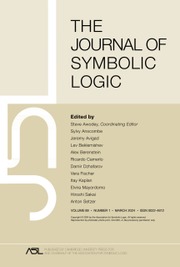Article contents
Sets with no subset of higher degree1
Published online by Cambridge University Press: 12 March 2014
Extract
The problem of finding an infinite set of natural numbers which contains no subsets of higher (Turing) degree was first posed by W. Miller [3] and was brought to our attention by C. G. Jockusch, Jr., who proved that such a set, if it existed, could not be hyperarithmetic.2 In this paper we construct an infinite set which is not recursive in any of its coinfinite subsets, and thus contains no subset of higher degree. Our original proof made use of the result (attributed to Ehrenfeucht) that every subset of 2ω which is open (in the standard topology) is “Ramsey”.
Information
- Type
- Research Article
- Information
- Copyright
- Copyright © Association for Symbolic Logic 1969
Footnotes
This work was partly supported by National Science Foundation Grant GP8866. We are very grateful to C. G. Jockusch, Jr. for corrections, for several helpful discussions on the problem, and for supplying relevant information. We are also grateful to F. Galvin for telling us immediately of his results. An infinite set not recursive in any coinfinite subset was constructed simultaneously and independently by P. J. Cohen (unpublished).
References
- 17
- Cited by

